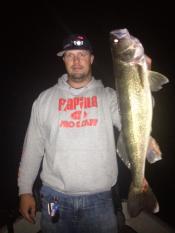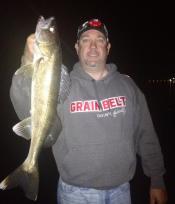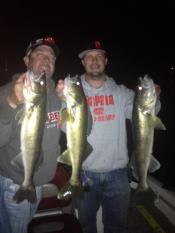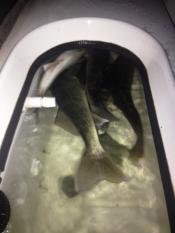 One of the keys to finding early spring walleyes on Mille Lacs Lake is finding where the baitfish are congregating. These baitfish consisting of yellow perch, spottail shiners, bluntnose minnows are usually relating to newly emerged weedbeds. If you can find these new weed beds on top of flats or along breaklines, you’re bound to find the baitfish and odds are the walleyes are close by.
One of the keys to finding early spring walleyes on Mille Lacs Lake is finding where the baitfish are congregating. These baitfish consisting of yellow perch, spottail shiners, bluntnose minnows are usually relating to newly emerged weedbeds. If you can find these new weed beds on top of flats or along breaklines, you’re bound to find the baitfish and odds are the walleyes are close by.
Last night I joined Troy Rahn and Brandon Smoley for some night time trolling. Thanks to a tip from a friend of ours (Shawn McGuire) who had success while trolling the night before, our excitement was high! Spontaneous plans were made literally hours before we met and we decided to fish out of Troy’s boat.
Over the course of 5 hours, we trolled crankbaits from sunset to 2am in 13-15 feet of water and ended up catching 27 walleyes. Most were between 22-26 inches. We also caught our limit of slot fish (6 walleyes between 18-20 inches) so that will make a couple of nice meals. We had a couple of doubles and even a triple last night! Having 3 experienced anglers working in unison while fishing in the dark paid off! It was a beautiful night and the lake was like glass. After the sun went down, we were also treated to a heat show that was far off to our south. We kept an eye on the radar and it was easy to see that we were not in any danger. Needless to say, it was a very memorable evening.
 Here are the keys to our success:
Here are the keys to our success:
At night, the walleyes like to use newly formed weedbeds as ambush points. Many anglers say walleyes relate to structure. The only reason why walleyes are relating to that structure is because it congregates baitfish. If you find structure, you may find the walleyes. If you find the baitfish, you will always find the walleyes!
It’s important to understand that there are inside weedlines and outside weedlines. Outside weedlines are where the weeds end and are closest to deep water. Most anglers only troll outside weedlines. Inside weedlines are a little more difficult to find and may not exist because the weeds can grow all the way to the shoreline. However, there are areas where the weeds stop growing in between the shoreline and if you can find an inside weedline especially during low light conditions or at night, it can be deadly.
 A walleye’s ambush point can also be an inside turn of a breakline. Last night, we literally caught over half of our fish in this situation. Walleyes love to hang out in schools and these inside corners help them ambush their prey. Other breaklines that are good are bottom transitions such as weeds to gravel, sand to gravel, sand to mud and any combination of these. Learn how to detect hard to soft bottom breaklines on your sonar. These transition breaklines are excellent areas to troll because it also attracts baitfish.
A walleye’s ambush point can also be an inside turn of a breakline. Last night, we literally caught over half of our fish in this situation. Walleyes love to hang out in schools and these inside corners help them ambush their prey. Other breaklines that are good are bottom transitions such as weeds to gravel, sand to gravel, sand to mud and any combination of these. Learn how to detect hard to soft bottom breaklines on your sonar. These transition breaklines are excellent areas to troll because it also attracts baitfish.
Time of year and water temperatures can help you figure out which crankbait profile is best and the lure action. Due to the late ice this spring, water temps on Mille Lacs Lake are still pretty cool for mid-June (low 60’s) and these fish are still somewhat lethargic and in slow motion. Right now a slow wobble action lure will most likely entice these fish versus a fast aggressive action lure. Walleyes are lazy and are waiting in these ambush points looking for an easy meal. If they have to exert a lot of energy chasing down an aggressive lure, they may pass. The key is to present your crankbait as an easy meal to as many walleyes as possible and within the strike zone of these ambush points.
 Many anglers love to position their crankbait right near the bottom of the structure. They find something that works and therefore they have confidence in that presentation. Don’t be afraid to test different depths within the water column. Walleyes typically chase and ambush their prey from underneath. The baitfish are easy targets and cannot see what is underneath them. When walleyes are aggressively feeding, you will usually find them feeding higher in the water column. Many baitfish feed up at night on zooplankton so the walleyes will follow. As night progressed, we started catching more walleyes higher in the water column.
Many anglers love to position their crankbait right near the bottom of the structure. They find something that works and therefore they have confidence in that presentation. Don’t be afraid to test different depths within the water column. Walleyes typically chase and ambush their prey from underneath. The baitfish are easy targets and cannot see what is underneath them. When walleyes are aggressively feeding, you will usually find them feeding higher in the water column. Many baitfish feed up at night on zooplankton so the walleyes will follow. As night progressed, we started catching more walleyes higher in the water column.
The vibration of your lure is also important to understand. Picking out a lure with the right action and the right vibration is another key to success. As your lure is trolled, it displaces water and gives off a vibration which attracts the walleye’s attention. The walleye has a finely tuned lateral-line that helps them detect the slightest vibration. Most anglers pay too much attention to color and not enough on lure action and vibration. Walleyes will detect that vibration first before it sees your lure. Walleyes can also detect differences. Their lateral line allows them to pick out a wounded baitfish or one that is swimming differently compared to others. Again… it’s an easy meal. Understanding the vibration of your lure and choosing a lure with a built in rattle may be the ticket.
Now that the night band has been lifted, it’s time to get out there and experience night trolling. Hopefully the information above will help you get started and put some walleyes in your boat!
Until next time – keep trollin’!
nice
Thanks Brad. Heading up tomorrow for a few days and I will definitely try some night trolling!
Brad,
Excellent REport, It’s not only Oct/Nov time trolling anymore.
Awesome,
Jack
Awesome Report. Night trolling cranks is one of my favorite ways to fish.
Can you enlighten us on the “go to” crank you used?
My favs are the Flat Rap and Shad rap.
It changes daily out there but some of my favorites are:
– Rapala SSR 7’s, Shad Raps RS 5,& 7’s and Deep Down Husky Jerks 10’s
– Reef Runner Rip Sticks 700’s and Deep Little Rippers
– Smithwicks Suspending Rattling Rogues
I’m excited to try out the new Rapala Scatter Rap Shad, the Scatter Rap Minnow and the new Storm Smash Shads!